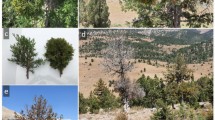Abstract
Seasonal variation of paulownia witches’-broom (PWB) phytoplasma within different organs (leaves, branch and trunk bark and roots) in paulownia trees was investigated by the amplification of a PWB-specific DNA fragment by the polymerase chain reaction (PCR). In leaf samples, PWB phytoplasma was first detected in June and the incidence gradually increased. On the other hand, the PWB was detected at relatively low incidence in branch bark, trunk bark and roots and the incidence did not change among seasons. A survey of PWB in 27 fields in the Tohoku district of Japan showed that malformed flower buds were observed in paulownia trees in almost all of the fields. PWB-phytoplasma was also detected by PCR from paulownia trees in almost all of the fields in Iwate and Fukushima Prefectures. The frequencies of trees in which phytoplasma was detected by PCR were higher than those in which symptoms were observed. These results indicated that PCR amplification of a PWB-specific DNA fragment is an effective tool for practical diagnose and that PWB is widely distributed in the Tohoku district of Japan.
Similar content being viewed by others
Literature cited
Arens, U. and Seemüller, E. (1994) Detection of mycoplasmalike organisms in declining oaks by polymerase chain reaction. Eur. J. For. Pathol. 24: 55–63.
Chen, J., Chang, C.J., and Jarret, R.E. (1992) DNA probes as molecular markers to monitor the seasonal occurrence of walnut witches’-broom mycoplasmalike organisms. Plant Dis. 76: 1116–1119.
Douglas, S.M. (1986) Detection of mycoplasmalike organisms in peach and chokecherry with X-disease by fluorescence microscopy. Phytopathology 76: 784–787.
Firrao, G., Gobbi, E., and Locci, R. (1994) Rapid diagnosis of apple proliferation mycoplasma-like organism using a polymerase chain reaction procedure. Plant Pathol. 43: 669–674.
Kusunoki, M., Okudaira, T., Kobayashi, M., and Hiruki, C. (1994) Hovenia (Hovenia tomentosa) yellows, caused by mycoplasma-like organisms (MLOs) in Japan. J. Jpn. For. Soc. 76: 78–83.
Lederer, W. and Seemüller, E. (1992) Demonstration of mycoplasmas in Prunus species in Germany. J. Phytopathol. 134: 89–96.
Nakamura, H., Yoshikawa, N., Takahashi, T., Sahashi, N., Kubono, T., and Shoji, T. (1996) Evaluation of primer pairs for reliable diagnosis of paulownia witches’-broom disease using a polymerase chain reaction. Plant Dis. 80: 302–305.
Sahashi, N., Nakamura, N., Yoshikawa, N., Kubono, T., Shoji, T., and Takahashi, T. (1995) Distribution and seasonal variation in detection of phytoplasma in bark phloem tissues of single paulownia trees infected with witches’ broom. Ann. Phytopathol. Soc. Jpn. 61: 481–484.
Sato, K. (1963) Occurrence of paulownia witches’ broom in the Tohoku district in Japan. For. Protect. 13: 53 (in Japanese).
Schaper, U. and Converse, R.H. (1985) Detection of mycoplasmalike organisms in infected blueberry cultivars by the DAPI technique. Plant Dis. 69: 193–196.
Seemüller, E. (1988) Colonization patterns of mycoplasmalike organisms in trees affected by apple proliferation and pear decline.In Tree mycoplasma and mycoplasma diseases. Hiruki, C. (ed.), 245 pp, The University of Alberta Press, Alberta, 179–192.
Seemüller, E., Kunze, L., and Schaper, U. (1984a) Colonization behavior of MLO, and symptom expression of proliferation-diseased apple trees and decline-diseased pear trees over a period of several years. Z. Pflanzenkrankh. Pflanzenschutz. 91: 525–532.
Seemüller, E., Schaper, U., and Zimbelmann, F. (1984b) Seasonal variation in the colonization patterns of mycoplasmalike organisms associated with apple proliferation and pear decline. Z. Pflanzenkrankh. Pflanzenschutz. 91: 371–382.
Sinclair, W.A., Griffiths, H.M., Davis, R.E., and Lee, I.-M. (1992) Detection of Ash yellows mycoplasmalike organisms in different tree organs and in chemically preserved specimens by a DNA probevs. DAPI. Plant Dis. 76: 154–158.
Takamura, N. and Sakuyama, T. (1979) The detection of mycoplasmalike organisms from paulownia trees infected with paulownia witches’ broom in Iwate Prefecture. Forest Pests 28: 7–9 (in Japanese).
Tsai, J.H., Chen, X.-Y., Shen, C.-Y., and Jin, K.-X. (1988) Mycoplasmas and fastidious vascular prokaryotes associated with tree diseases in China.In Tree mycoplasma and mycoplasma diseases. Hiruki, C. (ed.), 245 pp, The University of Alberta Press, Alberta, 69–96.
Yoshikawa, N., Nakamura, H., Sahashi, N., Kubono, T., Katsube, K., Shoji, T., and Takahashi, T. (1994) Amplification and nucleotide sequences of ribosomal protein and 16S rRNA genes of mycoplasmalike organism associated with paulownia witches’ broom. Ann. Phytopathol. Soc. Jpn. 60: 569–575.
Author information
Authors and Affiliations
About this article
Cite this article
Nakamura, H., Ohgake, S., Sahashi, N. et al. Seasonal variation of paulownia witches’-broom phytoplasma in paulownia trees and distribution of the disease in the Tohoku district of Japan. J For Res 3, 39–42 (1998). https://doi.org/10.1007/BF02760291
Accepted:
Issue Date:
DOI: https://doi.org/10.1007/BF02760291




